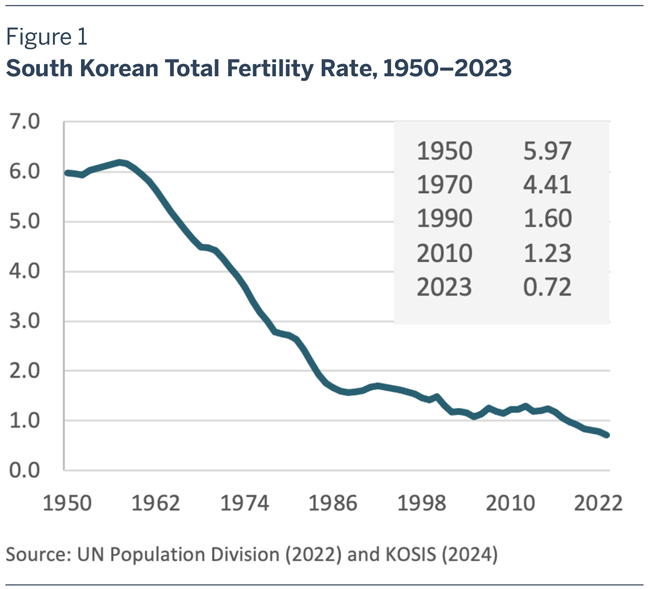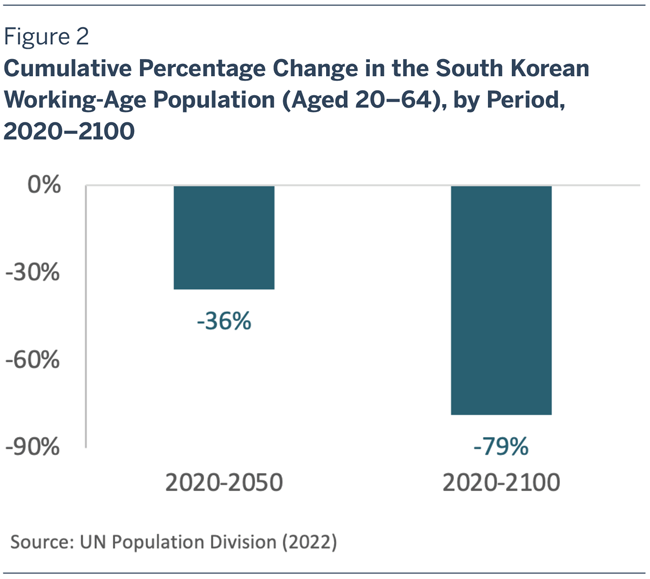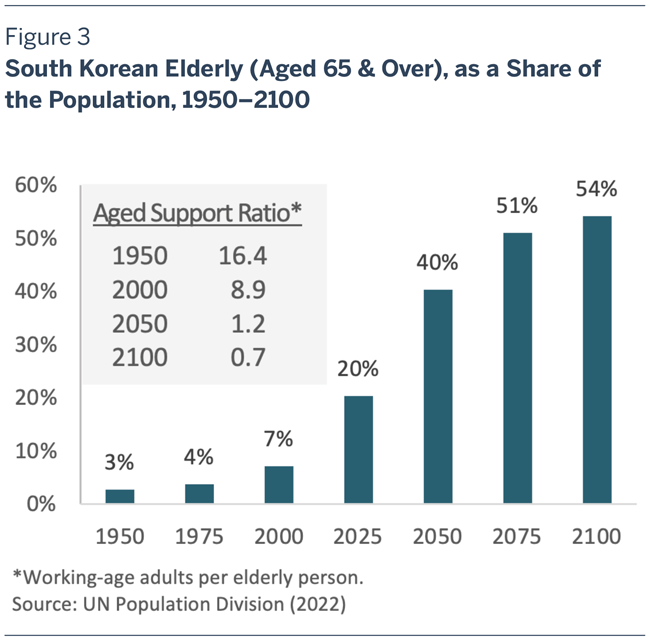Lessons from South Korea’s Fertility Freefall
Vantage Point: Mini Briefs from The Terry Group and the Global Aging Institute
March 27, 2024

South Korea’s fertility rate fell to just 0.72 in 2023, another world record low and barely one-third of the 2.1 replacement rate needed to maintain a stable population. Its fertility freefall has many lessons for other developed countries, the most important being that seeking to maintain traditional gender roles does not raise birthrates, but lowers them.
According to new data released by Statistics Korea in February, South Korea’s fertility freefall continues to gather momentum. Its total fertility rate (TFR), a measure of average lifetime births per woman, sank to just 0.72 in 2023, by far the lowest in the world and barely one-third of the 2.1 replacement rate needed to maintain a stable population from one generation to the next.
To say that a TFR this low poses an existential threat is not to engage in hyperbole, but merely to recognize the realities of demographic arithmetic. Unless birthrates rise, by 2050 there will be more South Koreans turning ninety each year than being born. By 2075, half of the country’s population will be elderly. By 2100, its total population will have shrunk by more than 60 percent and its working-age population will have shrunk by nearly 80 percent.1
South Korea’s fertility freefall is being accelerated by a combination of uniquely powerful impediments to family formation, from a cutthroat educational system that inflates the cost of childrearing to traditional family and workplace cultures that render motherhood and career virtually incompatible. Nonetheless, its experience has important lessons for other developed countries, including the United States.
What Sets South Korea Apart
In the 1950s, South Korea’s TFR still averaged a towering 6.1. But beginning in the 1960s, as the “Miracle on the Han River” that transformed the country from an impoverished agrarian society into a high-income industrial powerhouse got under way, birthrates fell rapidly. (See figure 1.) By the mid-1980s, South Korea’s TFR had dropped beneath the 2.1 replacement rate. Between the early 2000s and mid-2010s, it seemed to stabilize at around 1.2, an extremely low though not unprecedented level. But then it resumed its slide, falling beneath 1.0 in 2018. As of 2023 South Korea’s TFR stood at 0.72, and the government expects it to fall again in 2024.
Low fertility is of course nothing unusual today. Over the past half century, birthrates have fallen throughout most of the world. The causes include rising incomes, advances in educational attainment, especially of women, the availability of effective contraception, and the diffusion of a “middle-class” ethos that stresses the quality rather than the quantity of children. Among OECD countries, the TFR now averages 1.6.
What sets South Korea apart is that its TFR has sunk to levels which just a few years ago most demographers would have considered unimaginable. The explanation lies in a veritable witch’s brew of additional impediments to family formation that come on top of the broader social and economic trends that are depressing fertility almost everywhere. There is South Korea’s growing housing shortage, which makes it difficult for young adults to establish their own households. There is its two-tiered labor market, which locks many of them out of regular employment. And there is its cutthroat educational system with its all-or-nothing college entrance exam that compels parents to spend massively on private “cram schools” if their children are to stand a chance at success in life.
Most importantly, there are the expectations ingrained in the country’s traditional family and workplace cultures. The dizzying speed of South Korea’s economic development has far outpaced the ability of social norms to evolve, adjust, and adapt. The result is that the country now finds itself suspended somewhere between tradition and modernity.
On the one hand, South Korea is a high-income industrialized country that is home to global technology giants like LG and Samsung. From K-Pop to Squid Game, its cultural offerings have come to define the cutting edge of cool throughout East Asia and beyond. And its young adults, including its women, are highly educated. In fact, South Korea has one of the highest female college graduation rates in the world.
Yet at the same time, South Korean society remains deeply traditional in many ways. It has a conservative Confucian family culture whose dictates still shape expectations about gender roles in most marriages. It also has a paternalistic workplace culture that makes little allowance for working mothers. The workweek is punishingly long, the hours are inflexible, and if you step off the career ladder and take a leave of absence to have a child you will never get back on it.
Given all of this, it is hardly surprising that many South Korean women see little to gain and much to lose in having children—or even getting married. Asked whether a married couple should have children, just 33 percent of women in their twenties absolutely or somewhat agree that they should, while 67 percent somewhat or strongly disagree. Asked how important it is to them personally to get married, just 28 percent say that they must or would prefer to, with most of the rest saying that they are “indifferent.”2
In recent years, South Korea’s government has become increasingly alarmed about the country’s plunging TFR and has responded with a raft of policies designed to boost it, including monthly cash allowances for parents with young children, paid maternity and paternity leave, and subsidized daycare. Yet birthrates keep falling for a simple reason that the government does not seem to grasp: Changing fertility behavior will require eliminating the institutional and cultural impediments to family formation that caused birthrates to collapse in the first place.
Dire Consequences
While decisions about family formation are and should be a matter of individual choice, the collective fertility decisions of millions of individuals can have important consequences for society as a whole. In the case of South Korea, those consequences are likely to be dire.
South Korea’s working-age population is already contracting by 1 percent per year and will soon be contracting by 2 percent per year. All other things being equal, employment will contract in tandem with the working-age population. Unless productivity, or output per worker, rises at least as fast as employment falls, real GDP will begin to contract as well—not just during recessions, but across the business cycle from one normal year to the next. Higher immigration or higher labor-force participation might stave off economic decline for a while. But with South Korea projected to lose nearly 80 percent of its working-age population by the end of the century, there is no long-term solution unless fertility rises. (See figure 2.)
Even as economic growth slows, fiscal burdens will grow. Falling fertility, after all, not only hollows out the base of the population pyramid, it also leaves it top-heavy with elderly. (See figure 3.) South Korea had the poor timing to put in place its pay-as-you-go National Pension System in the late 1980s, just as its TFR was sinking beneath replacement. It has already cut promised income replacement rates twice, from 70 to 40 percent, yet the system is still careening toward bankruptcy. As the elderly share of the population continues to grow, South Korea will face an unenviable choice. It can cut benefits again, immiserating the elderly, or it can impose a crushing tax burden on the young that will further slow economic growth.
South Korea, like most Asian societies, has traditionally had strong extended families. As government benefits are curtailed, one might hope that they at least would continue to serve as a safety net for the elderly. But with birthrates so low, the extended family is gradually disappearing. Fewer brides today also means that there will be fewer daughters-in-law tomorrow, and in Confucian culture it is the daughter-in-law who is expected to care for her husband’s aged parents. Indeed, this expectation may be one more reason why women are reluctant to marry and birthrates are so low.
Cautionary Lessons
South Korea’s fertility freefall offers three cautionary lessons for the United States and other developed countries. The first is that there is no necessary lower limit to how far birthrates can fall—and no necessary reason that, once they have fallen, they will rise again.
When fertility rates in much of the developed world first sank beneath replacement in the 1970s, most demographers assumed it was an aberration and that they would soon bounce back. Indeed, for many years the UN built this expectation into its long-term projections, as if it were a law of nature that, absent war, pestilence, or some other catastrophe, populations never shrink. But there is no such law. With the exception of Israel, every developed country now has below-replacement fertility, and most have had below-replacement fertility for decades. South Korea may so far be the only country where the TFR has fallen beneath 1.0, but several others, including China, are flirting with the threshold.
The second lesson is that low fertility can be self-perpetuating. South Korea appears to have fallen into what demographers call a “low fertility trap.” When birthrates are high, young adults see their friends, neighbors, and colleagues having children, and this sends a social signal that family formation is normal, even expected. When birthrates are low, and have been low for more than a generation, having a small family or no family becomes the new social norm. The government may be encouraging young South Koreans to have children, but their peers aren’t.
The third and most important lesson is that, in modern societies, seeking to maintain traditional gender roles usually results in lower, not higher birthrates. While this may seem paradoxical, the reason is straightforward. Most women in today’s developed world want to have a career as well as a family. Those countries which make it difficult for them to achieve both aspirations end up with fewer of both of the crucial inputs that aging societies need: babies and workers. South Korea is a case in point. It not only has the lowest TFR in the world, but also has one of the lowest female labor-force participation rates in the OECD and by far the largest gender pay gap.3
The United States is not South Korea. Tradition and modernity are not at war here, and, however imperfectly, family and workplace cultures have evolved to accommodate a dual role for women. Yet America, whose TFR has fallen from 2.12 to 1.67 since the Great Recession, also finds itself in the midst of a worrisome fertility slump. The explanation appears to lie in the difficulties that young adults face in launching careers and establishing independent households, as well as their growing pessimism about their own and their children’s economic prospects.
Unless these circumstances improve, America’s TFR is unlikely to rise again. And the longer it remains low, the more difficult it will be to turn around.



